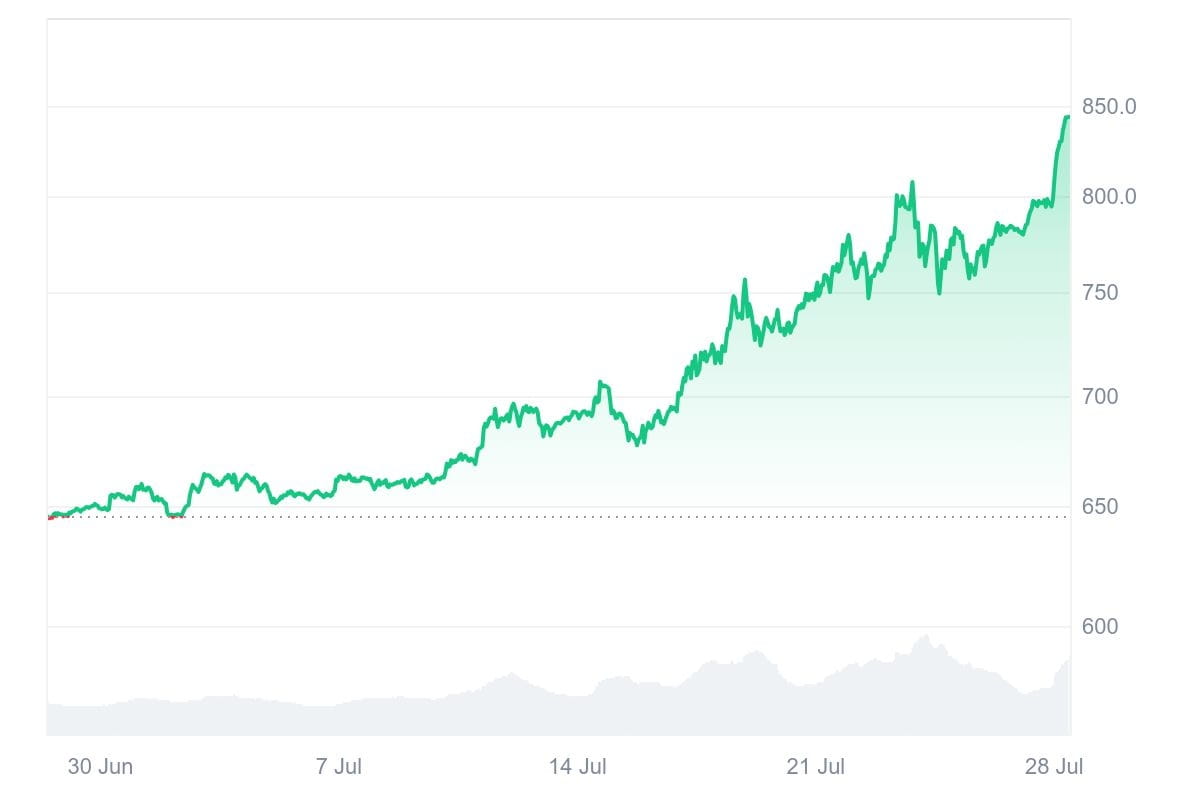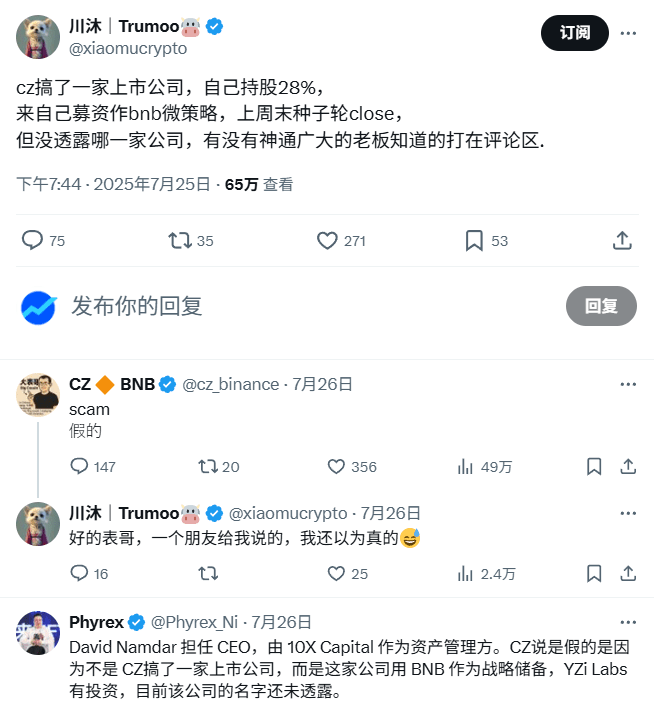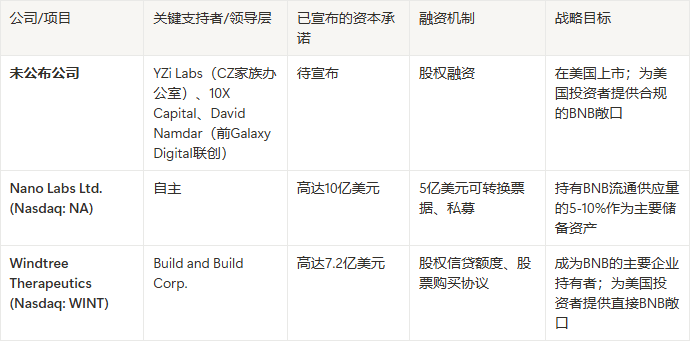Written by: Luke, Mars Finance
Recently, the price trend of BNB has broken a long-standing silence, surging past $850 with astonishing force, constantly refreshing historical highs. This outbreak has sparked widespread discussion and inquiry in the market, leaving many observers perplexed, having been accustomed to its volatility resembling that of stablecoins, suddenly finding it hard to understand the driving forces behind it. However, the surface price surge is merely the tip of the iceberg; what it deeply reflects may be a meticulously planned, fundamental strategic shift: BNB is transforming from a functional token deeply tied to a single exchange's fate into an institutional-grade reserve asset endorsed by the balance sheets of a number of listed companies.

The core of this transformation lies in the reshaping of its value capture pathway. In the past, the market generally believed that Binance would have to seek a traditional Initial Public Offering (IPO) route to embrace mainstream finance. Although this path is orthodox, it is fraught with thorns, especially in the heavily regulated U.S. market. It requires BNB to be legally 'de-risked' to avoid the risk of being classified as a security, which also imposes a heavy shackle on the valuation of BNB.
Today, a brand new path with more Web3 native characteristics is emerging. It no longer clings to the compliance listing of a single entity but instead builds a 'BNB reserve asset alliance' composed of multiple independent listed companies, creating a more decentralized and resilient bridge to Wall Street for BNB. The recent market's intense reaction is a first and direct pricing of this emerging capital narrative.
Valuation Cage: Self-Binding of the IPO Path
BNB has performed flatly for a long time, possibly due to the core constraints of the traditional IPO path—the Howey Test. According to the U.S. Securities and Exchange Commission (SEC), a transaction constitutes an 'investment contract,' i.e., a security, if it meets four major criteria: the investment of money, investment in a common enterprise, an expectation of profits, and the profits coming primarily from the efforts of others. For exchange tokens, the 'new share' benefits provided to holders through platforms like Launchpad easily touch the red line of 'profits coming from the efforts of others (project parties and exchanges).
To clear the obstacles on this compliance path, Binance has undergone a series of precise iterations of its product matrix over the past few years, with clear legal intentions. This is not simply a functional upgrade but a 'surgical operation' aimed at systematically stripping away the securities attributes of BNB.
The initial Binance Launchpad was a typical Initial Exchange Offering (IEO) model, where users gained participation shares in new project investments by holding BNB, which closely resembled the definition of an investment contract. Subsequently, Binance launched Launchpool, shifting the model to liquidity mining. Users provide liquidity for projects by staking BNB and other assets and receive new token rewards. This shift cleverly changes the narrative from 'investment' to 'farming,' although subtle, it legally weakens the direct association with 'common enterprise' and 'efforts of others.'
The latest evolution is the emergence of Megadrop. This platform not only requires users to lock BNB but also introduces a mechanism for completing Web3 tasks. This means that part of the rewards users receive depends on their active participation and 'proof of work,' rather than passively relying on third parties. From Launchpad to Launchpool, and now to Megadrop, the enabling method of BNB has gradually shifted from direct investment returns to a reward mechanism that requires more user involvement, closer to the native model of DeFi.
The cost of this series of operations is evident. It diluted the most direct and strongest economic incentives for holding BNB, leading to its performance in bull markets significantly lagging behind other top public chain tokens, with price fluctuations once nearing those of stablecoins. This 'valuation cage' built in pursuit of traditional IPOs, while legally prudent, directly resulted in long-term suppression of its market value and laid the groundwork for later strategic shifts.
Pioneer Tron: A Demonstration of Wall Street's Financial Techniques
Just as BNB was struggling on the path of compliance, another participant in the crypto world—Sun Yuchen (Justin Sun) and his Tron—staged a textbook-style breakout in the capital market, providing a new idea for all mainstream crypto assets. Tron did not choose the long and uncertain traditional IPO process; instead, it merged with the Nasdaq-listed company, toy manufacturer SRM Entertainment, through a reverse merger, quickly landing in the U.S. capital market.
The essence of this operation lies in the fact that it is not a simple shell listing but a complex financial engineering endeavor. The most critical step was when a related party of Sun Yuchen used $100 million worth of TRX tokens to subscribe for shares in the restructured new company (Tron Inc.). This move set a precedent: using crypto assets themselves as capital to directly purchase entry tickets into the traditional financial system. After the transaction, the balance sheet of the newly listed company Tron Inc. prominently featured hundreds of millions of TRX tokens, making it the world's largest TRX listed company reserve. The image of Sun Yuchen ringing the opening bell on Nasdaq symbolizes a successful convergence between the crypto world and Wall Street.
A deeper analysis reveals the power of this financial technique. It not only creates a compliant, publicly traded TRX proxy investment tool for traditional investors who cannot or do not wish to directly hold cryptocurrencies but also provides an efficient value realization channel for founding teams and early investors. Analysis indicates that by injecting tokens with costs close to zero at protocol prices into listed companies, coupled with the valuation premiums in public markets, it could theoretically create billions of dollars in paper profits. This model can both promote asset narratives and solve the problem of large-scale cashing out for founding teams, and its demonstration effect is significant. It proves to the market that by bypassing the rigorous scrutiny of direct IPOs and constructing reserve assets within listed companies, value reassessment and institutional acceptance can also be achieved.
A New Institutional Path for BNB
Inspired by the Tron case, a larger and more sophisticated strategic blueprint centered around BNB is rapidly unfolding. It is no longer a solo act by a single company, but rather an intention to create a 'BNB reserve asset constellation' composed of multiple listed companies, forming a diversified and sustained source of institutional demand.
The cornerstone of this operation stems from the collaboration between Binance founder Zhao Changpeng (CZ)’s family office YZi Labs and investment firm 10X Capital. According to reports from multiple media outlets (such as CoinDesk, The Block, etc.), YZi Labs, formerly known as Binance Labs and managing over $10 billion in assets, publicly announced its support for 10X Capital to establish a new company focused on purchasing and holding BNB, with plans to list on major U.S. securities exchanges. Crucially, the leader of this new company has been confirmed as David Namdar—the co-founder of the well-known digital asset financial services firm Galaxy Digital on Wall Street. This appointment sends a clear signal: this is not an internal game within the crypto circle, but a serious action led by top traditional financial talents aimed at opening up institutional funding channels.
Meanwhile, a market rumor has caused a stir: 'CZ has set up a public company, holding 28% of the shares, to raise funds for BNB micro-strategies.' This rumor quickly fermented, suggesting that CZ was directly manipulating things behind the scenes. In response to market speculation, Zhao Changpeng himself succinctly replied on social media X (formerly Twitter) with one word: 'scam / fake.' This response initially confused the market, but soon more detailed analyses clarified the facts: CZ's response did not deny the entire BNB reserve strategy, but rather precisely refuted the inaccurate information that 'he set up a public company and personally raised funds.' A closer interpretation of the facts is that there is indeed a new company with BNB as a strategic reserve, led by David Namdar as CEO, with 10X Capital as the asset management party, while CZ's family office YZi Labs is one of its investors, not a direct operator. This separation aligns with CZ's current legal identity and explains why he defined rumors directly attributed to him as 'fake.'

Beyond this main line, a 'pioneer fleet' composed of pioneers has set sail, demonstrating astonishing capital firepower. The Nasdaq-listed Chinese chip design company Nano Labs announced a BNB acquisition plan of up to $1 billion, funded by a $500 million convertible bond issuance, with the goal of holding 5% to 10% of the circulating supply of BNB for the long term. Recently, this company has acquired 120,000 BNB through over-the-counter (OTC) transactions, totaling approximately $90 million. Another Nasdaq-listed company, biotechnology firm Windtree Therapeutics, has also announced a transformation, securing financing commitments of up to $720 million through equity credit lines, most of which will be used to purchase and hold BNB.
What truly reveals the scale of its ambition is the information Zhao Changpeng disclosed on another occasion: 'More than 30 teams' are exploring the establishment of a BNB reserve asset public company. This indicates that what we are witnessing is no longer sporadic cases but a rising, coordinated capital movement.

Compared to Tron’s single-point breakthrough model, BNB's 'constellation' strategy is clearly a step further. It cultivates a decentralized public company network, building a more resilient and scalable capital bridge. This structure diversifies risk, avoids dependence on a single entity, and creates a sustained demand for BNB from multiple dimensions, serving as a profound practice of applying the decentralized ethos of Web3 to solve traditional finance connectivity issues.
Mutual Benefits: Building the Value Flywheel
Behind this strategic shift is a sophisticated, mutually beneficial value model. It cleverly combines BNB assets, core stakeholders, and the demands of traditional capital markets to form a powerful positive cycle.
First, for the BNB asset itself, this strategy creates an unprecedented 'permanent demand pool.' When BNB is written into the balance sheets of multiple listed companies, its identity shifts from a mere functional token dependent on on-chain activities to a digital commodity or strategic reserve asset recognized and endorsed by institutions. These purchases by listed companies are typically driven by capital market instruments such as issuing stocks or convertible bonds, making them structural and long-term rather than short-term speculative actions. This provides solid bottom support for BNB's price and introduces a new grand narrative based on institutional asset allocation into its valuation model.
Secondly, for Zhao Changpeng and the entire ecosystem, this is a highly intelligent layout in the post-regulatory and reconciliation era. By investing and supporting through his family office YZi Labs, he can maintain legal and operational distance from the Binance exchange, which the former CEO has vacated, thus continuing to promote the development of the BNB ecosystem while complying with legal agreements. As one of the largest holders of BNB, this strategy allows the value of his core asset to rise with the success of the entire 'BNB reserve constellation' without having to directly sell tokens on the open market, perfectly balancing personal legal constraints with maximum ecological economic impact.
Finally, for traditional capital markets, this model addresses the core 'access' issue. Many institutional and individual investors are unable to directly invest in crypto assets due to compliance and custody issues. However, purchasing a stock traded on Nasdaq, like Nano Labs (NA) or Windtree (WINT), is a simple, mature, and completely compliant operation. These listed companies act as 'converters,' encapsulating the complexities of the crypto world and providing a seamless interface for traditional capital, thus potentially guiding trillions of dollars from the global stock market into the BNB ecosystem.
Dawn of a New Paradigm
In summary, the recent price breakthrough of BNB is not without foundation. It is an external signal of BNB completing a profound transformation: evolving from a functional token constrained by compliance shackles to an institutional-grade reserve asset supported by public market capital. The pathway of this transformation is not through traditional direct IPOs, but rather leveraging and surpassing Tron’s financial techniques, innovatively constructing a 'reserve asset constellation' composed of multiple listed companies.
This model is expected to form a powerful value flywheel: listed companies purchase BNB, driving up prices; the rising BNB price enhances the asset value of these companies, further raising their stock prices; higher stock prices enable easier capital market financing; the new funds raised can then be used to purchase more BNB. Once this self-reinforcing cycle is established, it will provide continuous growth momentum for BNB.
More significantly, BNB's practice may signify the birth of a new paradigm—'Asset-Backed Network.' In this model, the value of a mature decentralized network is no longer solely defined by its on-chain economic activities, but rather supported by the value of the assets anchored behind it that flow in compliant capital markets. This may point to a new direction for how all mainstream crypto ecosystems can deeply integrate with the global financial system and draw strength from it. Therefore, the historical highs we see for BNB may not be the end of this market cycle, but rather the beginning of a grander narrative.


